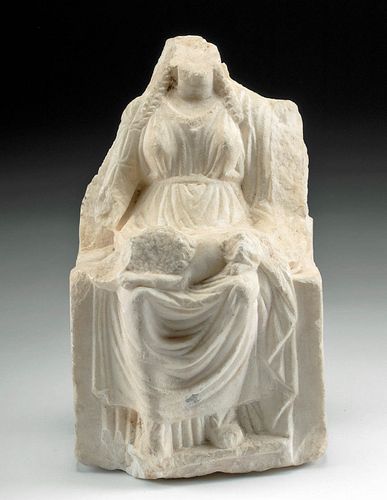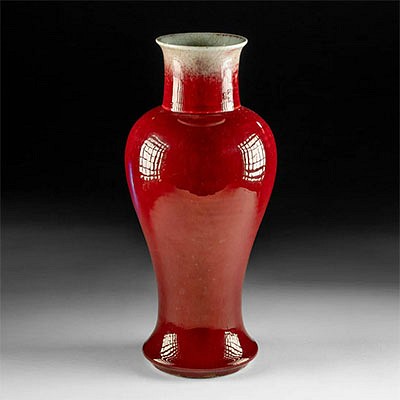Roman Marble Statue - Cybele / Draped Lion, ex-Harmer
Lot 39
About Seller
Artemis Gallery
686 S Taylor Ave, Ste 106
Louisville, CO 80027
United States
Selling antiquities, ancient and ethnographic art online since 1993, Artemis Gallery specializes in Classical Antiquities (Egyptian, Greek, Roman, Near Eastern), Asian, Pre-Columbian, African / Tribal / Oceanographic art. Our extensive inventory includes pottery, stone, metal, wood, glass and textil...Read more
Estimate:
$10,000 - $15,000
Absentee vs Live bid
Two ways to bid:
- Leave a max absentee bid and the platform will bid on your behalf up to your maximum bid during the live auction.
- Bid live during the auction and your bids will be submitted real-time to the auctioneer.
Bid Increments
| Price | Bid Increment |
|---|---|
| $0 | $25 |
| $300 | $50 |
| $1,000 | $100 |
| $2,000 | $250 |
| $5,000 | $500 |
| $10,000 | $1,000 |
| $20,000 | $2,500 |
| $50,000 | $5,000 |
| $100,000 | $10,000 |
| $200,000 | $20,000 |
About Auction
By Artemis Gallery
May 11, 2023
Set Reminder
2023-05-11 10:00:00
2023-05-11 10:00:00
America/New_York
Bidsquare
Bidsquare : Fine Antiquities, Asian, Pre-Columbian, Ethnographic Art
https://www.bidsquare.com/auctions/artemis-gallery/fine-antiquities-asian-pre-columbian-ethnographic-art-12771
Classical antiquities, ancient and ethnographic art from cultures encompassing the globe. Artemis Gallery info@artemisgallery.com
Classical antiquities, ancient and ethnographic art from cultures encompassing the globe. Artemis Gallery info@artemisgallery.com
- Lot Description
**First Time At Auction**
Roman, Imperial Period, ca. 1st to 3rd century CE. A finely carved statue depicting Cybele the Mother Goddess, known as Magna Mater or Great Mother in Rome, seated upon a throne with a lion laying across her lap. Cybele is traditionally shown in the company of lions or transported on a lion-drawn chariot and is oftentimes associated with wild animals, particularly lions. A pair of braids fall onto her shoulders, just above her supple breasts, which are draped by the billowing folds of a chiton that belts at her waist. A himation cascades over her left shoulder, falling behind her back, as a sleeve with a decorative pulled pattern covers her right arm. The petite feline lays atop her knees, facing left. Her left arm would have previously held a tympanum, an allusion to the ecstatic dances performed by her followers. This depiction of the goddess is based on a gold and ivory statue by the Greek sculptor Pheidias or Agorakritos of the late 5th century B.C.E. Size: 5.5" L x 6.6" W x 11" H (14 cm x 16.8 cm x 27.9 cm)
This style of portrayal of the goddess - seated, flanked by lions - may be 8000 years old! The Seated Woman of Catalhoyuk, dated to ca. 6000 BCE, depicts a woman seated in the same way, with her arms resting on felines who flank her lower body as she gives birth. Although this portrayal does not explicitly reference fertility or birth, its form - and other Greek and Roman portrayals of this goddess - is similar enough to infer that they are related.
Indeed, Magna Mater is the Roman form of Cybele, a goddess with a following much more ancient than the Roman Empire. She was the Great Mother who had given birth to the other gods, all humans, and all animals. She had a large cult following in Anatolia, Phrygia, and Greece during the 1st millennium BCE which was clearly part of an older tradition stretching back to Catalhoyuk. Her image often appears in conjunction with funerary rituals and tombs, as she was seen as a mediator of the liminal spaces between life and death.
Lions were famously featured in many ancient myths, perhaps the most famous being that of Hercules (Herakles) slaying the Nemean lion for his first labor. In this example, they are accompanying Cybele, the Mother Goddess of Rome. Lions were also favorite iconography for buildings, coins, and statues. Examples include the Lion Gate to the Citadel of Mycenae, the Terrace of the Lions on the island of Delos, and the lion hunt mosaic from Pella featuring Alexander engaged in a lion hunt. Of course lions were also used in the Roman arenas where they would fight other animals, such as tigers and bears.
Similar statues can be found at the Metropolitan Museum of Art (22.139.24), Staatliche Antikensammlungen in Munich, Museum fur Kunst und Gewerbe in Hamburg, the Fitzwilliam Museum at Cambridge (89405), and Musee du Louvre (CA 1797).
Provenance: private New York, New York, USA collection; ex-Harmer Rooke Galleries, New York City, New York, USA, July 25th 1991, lot 378
All items legal to buy/sell under U.S. Statute covering cultural patrimony Code 2600, CHAPTER 14, and are guaranteed to be as described or your money back.
A Certificate of Authenticity will accompany all winning bids.
We ship worldwide and handle all shipping in-house for your convenience.
#178340Missing head, arms, tympanum, and right foot of goddess, as well as top of throne and head and legs of lion. Chipping with losses to base, and nicks and abrasions throughout, commensurate with age. Nice remaining detail. Annular socketing hole in base from previous display.Condition
- Shipping Info
-
All shipping is handled in-house for your convenience. Your invoice from Artemis Gallery will include shipping calculation instructions. If in doubt, please inquire BEFORE bidding for estimated shipping costs for individual items. In most cases Artemis Gallery cannot ship to Australia and Germany, please inquire before bidding.
-
- Buyer's Premium



 EUR
EUR CAD
CAD AUD
AUD GBP
GBP MXN
MXN HKD
HKD CNY
CNY MYR
MYR SEK
SEK SGD
SGD CHF
CHF THB
THB














